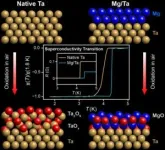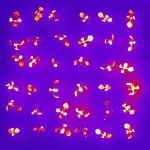(Press-News.org) UPTON, NY—Scientists at the U.S. Department of Energy’s (DOE) Brookhaven National Laboratory have discovered that adding a layer of magnesium improves the properties of tantalum, a superconducting material that shows great promise for building qubits, the basis of quantum computers. As described in a paper just published in the journal Advanced Materials, a thin layer of magnesium keeps tantalum from oxidizing, improves its purity, and raises the temperature at which it operates as a superconductor. All three may increase tantalum’s ability to hold onto quantum information in qubits.
This work builds on earlier studies in which a team from Brookhaven’s Center for Functional Nanomaterials (CFN), Brookhaven’s National Synchrotron Light Source II (NSLS-II), and Princeton University sought to understand the tantalizing characteristics of tantalum, and then worked with scientists in Brookhaven’s Condensed Matter Physics & Materials Science (CMPMS) Department and theorists at DOE’s Pacific Northwest National Laboratory (PNNL) to reveal details about how the material oxidizes.
Those studies showed why oxidation is an issue.
“When oxygen reacts with tantalum, it forms an amorphous insulating layer that saps tiny bits of energy from the current moving through the tantalum lattice. That energy loss disrupts quantum coherence—the material’s ability to hold onto quantum information in a coherent state,” explained CFN scientist Mingzhao Liu, a lead author on the earlier studies and the new work.
While the oxidation of tantalum is usually self-limiting—a key reason for its relatively long coherence time—the team wanted to explore strategies to further restrain oxidation to see if they could improve the material’s performance.
“The reason tantalum oxidizes is that you have to handle it in air and the oxygen in air will react with the surface,” Liu explained. “So, as chemists, can we do something to stop that process? One strategy is to find something to cover it up.”
All this work is being carried out as part of the Co-design Center for Quantum Advantage (C2QA), a Brookhaven-led national quantum information science research center. While ongoing studies explore different kinds of cover materials, the new paper describes a promising first approach: coating the tantalum with a thin layer of magnesium.
“When you make a tantalum film, it is always in a high-vacuum chamber, so there is not much oxygen to speak of,” said Liu. “The problem always happens when you take it out. So, we thought, without breaking the vacuum, after we put the tantalum layer down, maybe we can put another layer, like magnesium, on top to block the surface from interacting with the air.”
Studies using transmission electron microscopy to image structural and chemical properties of the material, atomic layer by atomic layer, showed that the strategy to coat tantalum with magnesium was remarkably successful. The magnesium formed a thin layer of magnesium oxide on the tantalum surface that appears to keep oxygen from getting through.
“Electron microscopy techniques developed at Brookhaven Lab enabled direct visualization not only of the chemical distribution and atomic arrangement within the thin magnesium coating layer and the tantalum film but also of the changes of their oxidation states,” said Yimei Zhu, a study co-author from CMPMS. “This information is extremely valuable in comprehending the material’s electronic behavior,” he noted.
X-ray photoelectron spectroscopy studies at NSLS-II revealed the impact of the magnesium coating on limiting the formation of tantalum oxide. The measurements indicated that an extremely thin layer of tantalum oxide—less than one nanometer thick—remains confined directly beneath the magnesium/tantalum interface without disrupting the rest of the tantalum lattice.
“This is in stark contrast to uncoated tantalum, where the tantalum oxide layer can be more than three nanometers thick—and significantly more disruptive to the electronic properties of tantalum,” said study co-author Andrew Walter, a lead beamline scientist in the Soft X-ray Scattering & Spectroscopy program at NSLS-II.
Collaborators at PNNL then used computational modeling at the atomic scale to identify the most likely arrangements and interactions of the atoms based on their binding energies and other characteristics. These simulations helped the team develop a mechanistic understanding of why magnesium works so well.
At the simplest level, the calculations revealed that magnesium has a higher affinity for oxygen than tantalum does.
“While oxygen has a high affinity to tantalum, it is ‘happier’ to stay with the magnesium than with the tantalum,” said Peter Sushko, one of the PNNL theorists. “So, the magnesium reacts with oxygen to form a protective magnesium oxide layer. You don’t even need that much magnesium to do the job. Just two nanometers of thickness of magnesium almost completely blocks the oxidation of tantalum.”
The scientists also demonstrated that the protection lasts a long time: “Even after one month, the tantalum is still in pretty good shape. Magnesium is a really good oxygen barrier,” Liu concluded.
The magnesium had an unexpected beneficial effect: It “sponged out” inadvertent impurities in the tantalum and, as a result, raised the temperature at which it operates as a superconductor.
“Even though we are making these materials in a vacuum, there is always some residual gas—oxygen, nitrogen, water vapor, hydrogen. And tantalum is very good at sucking up these impurities,” Liu explained. “No matter how careful you are, you will always have these impurities in your tantalum.”
But when the scientists added the magnesium coating, they discovered that its strong affinity for the impurities pulled them out. The resulting purer tantalum had a higher superconducting transition temperature.
That could be very important for applications because most superconductors must be kept very cold to operate. In these ultracold conditions, most of the conducting electrons pair up and move through the material with no resistance.
“Even a slight elevation in the transition temperature could reduce the number of remaining, unpaired electrons,” Liu said, potentially making the material a better superconductor and increasing its quantum coherence time.
“There will have to be follow-up studies to see if this material improves qubit performance,” Liu said. “But this work provides valuable insights and new materials design principles that could help pave the way to the realization of large-scale, high-performance quantum computing systems.”
This research was funded by the DOE Office of Science. The scientists used the Spectroscopy Soft and Tender Beamlines (SST-1 and SST-2) at NSLS-II, which are operated by the National Institute of Standards and Technology (NIST); Materials Synthesis & Characterization, Proximal Probe, and Electron Microscopy facilities at CFN; facilities of the Electron Microscopy and Nanostructure Group and Advanced Energy Materials Group in CMPMS; and computational resources of the National Energy Research Scientific Computing Center (NERSC) at DOE’s Lawrence Berkeley National Laboratory. CFN, NSLS-II, and NERSC are DOE Office of Science user facilities. The study included additional co-authors from CFN, CMPMS, NSLS-II, PNNL, Princeton University, Stony Brook University, and NIST.
Brookhaven National Laboratory is supported by the Office of Science of the U.S. Department of Energy. The Office of Science is the single largest supporter of basic research in the physical sciences in the United States and is working to address some of the most pressing challenges of our time. For more information, visit science.energy.gov.
Follow @BrookhavenLab on social media. Find us on Instagram, LinkedIn, X, and Facebook.
Related Links
Scientific paper: "Ultrathin Magnesium-based Coating as an Efficient Oxygen Barrier for Superconducting Circuit Materials"
Direct View of Tantalum Oxidation that Impedes Qubit Coherence
Understanding the Tantalizing Benefits of Tantalum for Qubits END
Magnesium protects tantalum, a promising material for making qubits
Thin-film coating prevents oxidation that impairs superconductivity and quantum coherence
2024-02-05
ELSE PRESS RELEASES FROM THIS DATE:
From Colombia to Laos: protecting crops through nanotechnology
2024-02-05
In a recent breakthrough, DNA sequencing technology has uncovered the culprit behind cassava witches’ broom disease: the fungus genus Ceratobasidium.
The cutting-edge nanopore technology used for this discovery was first developed to track the COVID-19 virus in Colombia, but is equally suited to identifying and reducing the spread of plant viruses. The findings, published in Scientific Reports, will help plant pathologists in Laos, Cambodia, Vietnam and Thailand protect farmers’ valued cassava harvest.
“In Southeast ...
New guideline details acute pain management strategies for adolescent, adult dental patients
2024-02-05
CHICAGO, Feb. 5, 2024 – Nonsteroidal anti-inflammatory drugs (NSAIDs) taken alone or along with acetaminophen are recommended as first-line treatments for managing short-term dental pain in adults and adolescents aged 12 or older, according to a new clinical practice guideline developed by the American Dental Association (ADA), the University of Pittsburgh School of Dental Medicine and the Center for Integrative Global Oral Health at the University of Pennsylvania School of Dental Medicine. The guideline has been endorsed by the ADA and is now available in the February issue of The Journal ...
How ‘deaths of despair’ differ by race and ethnicity
2024-02-05
COLUMBUS, Ohio – White Americans are more likely than Black and Hispanic people in the United States to experience “deaths of despair” even though they are less likely to suffer from severe psychological distress, a new study finds.
The results suggest that, for some reason, whites are more vulnerable to the damaging effects of psychological distress than Blacks or Hispanics, said Hui Zheng, lead author of the study and professor of sociology at The Ohio State University. Zheng is currently on leave at the University of Hong Kong.
“The white population has an increasing trend of despair-related mortality after 2000,” Zheng said. ...
Understanding how soil traps carbon
2024-02-05
EVANSTON, Ill. — When carbon molecules from plants enter the soil, they hit a definitive fork in the road.
Either the carbon gets trapped in the soil for days or even years, where it is effectively sequestered from immediately entering the atmosphere. Or it feeds microbes, which then respire carbon dioxide (CO2) into the ever-warming environment.
In a new study, Northwestern University researchers determined the factors that could tip plant-based organic matter in one direction or the other.
By combining laboratory experiments and molecular modeling, researchers ...
USC researchers uncover biological circuit that protects plants from extreme conditions
2024-02-05
Climate change is already harming agricultural yields and may one day pose a significant threat to the world’s food supply. Engineering more resilient crops, including those able to thrive in the face of drought or high soil salinity levels, is an increasingly urgent need.
A new study from the Keck School of Medicine of USC, funded in part by the National Institutes of Health, reveals details about how plants regulate their responses to stress that may prove crucial to those efforts. Researchers found that plants use their circadian clocks to respond to changes in external water and salt levels throughout the day. That same circuitry—an ...
Study reveals significant discrepancies in common poverty measurement approaches
2024-02-05
Methods commonly used to measure poverty can lead to vastly different conclusions about who actually lives in poverty, according to a new Stanford University-led study. Based on household surveys in sub-Saharan Africa, the first-of-its-kind analysis, published Feb. 5 in Proceedings of the National Academy of Sciences, underscores the importance of accurately defining and measuring poverty. Its findings could help inform how governments, nonprofit organizations, and international development agencies allocate resources and evaluate the effectiveness of poverty-alleviation policies around the world.
“They say you can’t manage what ...
Mystery of moths’ warning sound production explained in new study
2024-02-05
The workings of the ultrasonic warning sounds produced by the wings of a species of moth have been revealed by researchers at the University of Bristol.
Scientists recently discovered that moths of the genus Yponomeuta (so-called ermine moths) have evolved a very special acoustic defence mechanism against their echolocating predators—bats.
Ermine moths produce ultrasonic clicking sounds twice per wingbeat cycle using a minute corrugated membrane in their hindwing. Strikingly, these moths lack hearing organs and are therefore not aware of their unique defence mechanism, nor do they have the capability to control it using muscular ...
MIT researchers map the energy transition’s effects on jobs
2024-02-05
A new analysis by MIT researchers shows the places in the U.S. where jobs are most linked to fossil fuels. The research could help policymakers better identify and support areas affected over time by a switch to renewable energy.
While many of the places most potentially affected have intensive drilling and mining operations, the study also measures how areas reliant on other industries, such as heavy manufacturing, could experience changes. The research examines the entire U.S. on a county-by-county level.
“Our result ...
It’s true, happiness doesn’t cost much
2024-02-05
THIS PRESS RELEASE IS EMBARGOED UNTIL FEBRUARY 5, 2024 at 3:00 PM U.S. EASTERN TIME
Many Indigenous peoples and local communities around the world are leading very satisfying lives despite having very little money. This is the conclusion of a study by the Institute of Environmental Science and Technology of the Universitat Autònoma de Barcelona (ICTA-UAB), which shows that many societies with very low monetary income have remarkably high levels of life satisfaction, comparable to those in wealthy countries.
Economic growth is often prescribed as a sure way of increasing the well-being of people in low-income countries, and ...
Lighting up Alzheimer’s-related proteins to allow for earlier disease detection
2024-02-05
Many neurodegenerative diseases, including Alzheimer’s and Parkinson’s, are difficult to diagnose before symptoms begin to appear. However, disease-related biomarkers such as aggregated proteins called amyloids could provide important insight much earlier, if they can be readily detected. Researchers publishing in ACS Sensors have developed one such method using an array of sensor molecules that can light up amyloids. The tool could help monitor disease progression or distinguish between different ...
LAST 30 PRESS RELEASES:
Numbers in our sights affect how we perceive space
SIMJ announces global collaborative book project in commemoration of its 75th anniversary
Air pollution exposure and birth weight
Obstructive sleep apnea risk and mental health conditions among older adults
How talking slows eye movements behind the wheel
The Ceramic Society of Japan’s Oxoate Ceramics Research Association launches new international book project
Heart-brain connection: international study reveals the role of the vagus nerve in keeping the heart young
Researchers identify Rb1 as a predictive biomarker for a new therapeutic strategy in some breast cancers
Survey reveals ethical gaps slowing AI adoption in pediatric surgery
Stimulant ADHD medications work differently than thought
AI overestimates how smart people are, according to HSE economists
HSE researchers create genome-wide map of quadruplexes
Scientists boost cell "powerhouses" to burn more calories
Automatic label checking: The missing step in making reliable medical AI
Low daily alcohol intake linked to 50% heightened mouth cancer risk in India
American Meteorological Society announces Rick Spinrad as 2026 President-Elect
Biomass-based carbon capture spotlighted in newly released global climate webinar recording
Illuminating invisible nano pollutants: advanced bioimaging tracks the full journey of emerging nanoscale contaminants in living systems
How does age affect recovery from spinal cord injury?
Novel AI tool offers prognosis for patients with head and neck cancer
Fathers’ microplastic exposure tied to their children’s metabolic problems
Research validates laboratory model for studying high-grade serous ovarian cancer
SIR 2026 delivers transformative breakthroughs in minimally invasive medicine to improve patient care
Stem Cell Reports most downloaded papers of 2025 highlight the breadth and impact of stem cell research
Oxford-led study estimates NHS spends around 3% of its primary and secondary care budget on the health impacts of heat and cold in England
A researcher’s long quest leads to a smart composite breakthrough
Urban wild bees act as “microbial sensors” of city health.
New study finds where you live affects recovery after a hip fracture
Forecasting the impact of fully automated vehicle adoption on US road traffic injuries
Alcohol-related hospitalizations from 2016 to 2022
[Press-News.org] Magnesium protects tantalum, a promising material for making qubitsThin-film coating prevents oxidation that impairs superconductivity and quantum coherence






